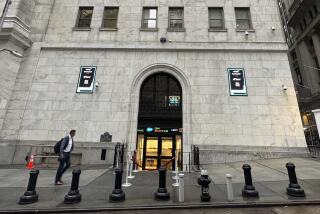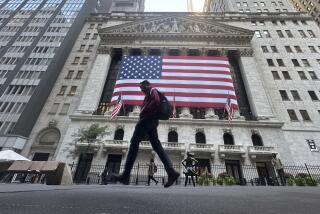The Dow: It’s Not Your Average Index
In a stunning rebuttal to Wall Street’s bears, the Dow Jones industrial average roared past the 3,300 mark on Tuesday, rising 36.23 points to a record 3,306.13.
The Dow’s latest surge continues the “Revenge of the Blue Chips”: the return to favor this year of the nation’s best-known and biggest stocks, many of which had badly lagged smaller stocks in 1991.
So far this year, the Dow has continued to hit new highs and now is up 4.3% from year’s end. In contrast, the NASDAQ composite index of small stocks is up just 1.4% for the year and has tumbled 7.8% from its February peak.
To put it another way, the Dow is rising nearly three times as fast as the average small stock this year, exactly the opposite of what happened last year.
And though the Dow is made up of just 30 stocks, the index’s unparalleled high profile with the public means the Dow stocks’ moves have tremendous power to influence investors’ attitudes toward the entire market--in this case, probably for the better.
There are many broader and arguably better indexes of the market’s trend, but “everybody still looks at the Dow,” notes David Dreman, a veteran New York money manager.
While Wall Street’s bears have argued that it is unhealthy for the Dow to be setting records while broader indexes flounder, the bulls say the market’s best hope is that a hot, headline-grabbing Dow will draw new attention to stocks, eventually pulling up everything else.
Why is the Dow on a streak? Three reasons stand out:
* Return to quality: Smaller stocks were the place to be last year, but the 57% rise in the NASDAQ index in 1991 (versus a 20% Dow rise) was probably too much, too soon. When Wall Street began to digest small-stocks’ gains in the first quarter, some investors decided that it was time to play it safer. That meant returning to blue chips.
Stocks of big companies are safer than those of smaller companies for obvious reasons, among them that big companies simply have proven staying power. But in addition, “Liquidity is a big factor now,” says Michael O’Higgins, a Latham, N.Y, money manager who has written a book about investing in Dow stocks. If the market suddenly turns down, O’Higgins notes, it’s always easier to sell a well-known, widely owned Dow stock than a little-known small stock.
* Return of the “cyclicals”: As more investors have come to believe that the economy is emerging from recession, demand has rocketed for shares of firms that usually benefit in the early stages of an upturn. These are the cyclical businesses, such as autos, steel, chemicals, machinery and paper.
The Dow, of course, is known as an industrial index. And of the 30 stocks in the Dow, 10 could be categorized as classic heavy-industry plays.
Bearish analysts warned in the first quarter that any earnings turnaround for the cyclical companies was far off, even if the economy were recovering. Yet quarterly earnings reports this week from Alcoa, IBM and International Paper suggested that a profit rebound has indeed begun. That drew a new herd of buyers to the stocks.
* Smart (or lucky) picking by Dow Jones: When Dow Jones & Co. chose Disney to replace steel giant USX in the Dow in 1991, some Wall Streeters scoffed. Why put an entertainment company in an industrial stock index? they asked.
Dow Jones’ reply is that the Dow should reflect not just the industrial economy, but the U.S. economy as a whole--which since 1970 has become dominated by consumer and service businesses.
And luckily for Dow fans, the consumer stocks that Dow Jones has substituted for some old-line industrial stocks in the index since 1979 have mostly been tremendous performers--helping to drive the Dow to its current heights.
Disney is just the latest example. The stock rocketed from $114.50 to $151.625 in the first quarter, a 32% rise that helped keep the Dow on pace even as some industrial stocks temporarily weakened. Likewise, food and tobacco giant Philip Morris, added in 1985, and Coca-Cola, added in 1987, were big factors in the Dow’s flight from 1,400 to nearly 3,000 between 1985 and 1990.
What if the Dow’s consumer stocks can’t duplicate their 1980s performance in the 1990s? If the economy continues to recover, the cyclical stocks should be able to pick up for the Dow where the consumer stocks left off, many analysts say.
What’s more, because of a peculiar aspect of the Dow, the gains of many of the consumer stocks will soon be “locked up” in the index anyway: Merck, Procter & Gamble and Disney, three of the highest-priced stocks in the Dow, will soon split their shares. Because the daily price moves of the Dow’s highest-priced stocks affect it more than the moves of its lower-priced stocks, the high-priced consumer stocks have had an outsized effect on the Dow in recent years.
Now, with their splits, the influence--good or bad--of those consumer stocks will automatically be lessened dramatically. So if the cyclical stocks are able to pick up from here, even if the consumer stocks fade “the Dow may have an open road ahead of it,” says analyst David Shulman at Salomon Bros.
Powering Dow to Record
The five stocks in the Dow average that rose the most on Tuesday, pushing the index to a new high:
Tues. close Pct. Stock and change gain Procter & Gamble 104 1/2, +4 1/2 +4.5% 3M Co. 91 3/4, +3 1/2 +4.0% Bethlehem Steel 13 7/8, + 1/2 +3.7% Intl. Paper 72 3/8, +2 3/8 +3.4% Sears 46 1/8, +1 1/4 +2.8%
What’s In the Dow
Here are the seven major industry groups in the Dow Jones industrial average, and how the 30 Dow stocks are distributed among those groups.
Stocks’ value as Industry Group pct. of Dow total Consumer products/services: Coca-Cola, Disney, Eastman Kodak, McDonald’s, Merck, Philip Morris, 3M Co., Procter & Gamble 40.2% Heavy industry: Alcoa, Bethlehem Steel Caterpillar, Dupont, GE, GM Goodyear, Intl. Paper, Union Carbide, Westinghouse 26.3% Oils: Chevron, Exxon, Texaco 9.9% Aerospace: Allied-Signal, Boeing, United Technologies 8.4% Technology: AT&T;, IBM 7.1% Financial: American Express, J.P. Morgan 4.1% Retailing: Sears, Woolworth 4.0%
More to Read
Inside the business of entertainment
The Wide Shot brings you news, analysis and insights on everything from streaming wars to production — and what it all means for the future.
You may occasionally receive promotional content from the Los Angeles Times.










